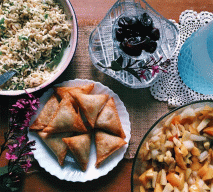
Using a spoon
Do you often use a fork or spoon to fuse in your ingredients, just like you’d do with your omelette? Think again! Grabbing your trusty wooden spoon or spatula to mix up your batter is your chief blunder! What you really want is a whisk — and that too, a large one. The larger the whisk, the more air gets whipped into the batter, making for the fluffiest stack of moist pancakes you can imagine.
Over mixing
Repeat after us: I will not mix my batter to bereavement. Turns out, those little lumps you try to whisk out are perfectly fine. And an overbeaten batter is actually worse than a lumpy mix. That’s because the more you mix, the more gluten develops in the batter, meaning you’ll end up with tough, chewy pancakes instead of ones that are fluffy and tender. We, in fact, make this mistake daily with our scrambled eggs too!
Not letting your batter rest
Shakespeare wasn’t mistaken when he stated that patience is a virtue! The statement holds true even when it comes to your pancakes. So don’t just plop a spoonful of batter on the griddle the second you finish mixing the wet and dry ingredients. Instead, let the batter sit for at least five to 10 minutes and up to 30. All that gluten that was activated when you whisked will relax, and the starch in the flour will absorb the liquid in the batter, making it denser, which is exactly what you want!
Using the wrong fat
Buttery pancakes are made when your skillet is greased with butter, right? Well... maybe, but if you’re constantly smoking yourself out of the kitchen when you cook, consider swapping it out for an oil like olive or canola. Butter actually has a low smoke point and can burn up in the pan, leaving you with blackened and stiff pancakes — not to forget, a hazy kitchen too!
Pouring oil straight into the pan
Are you pouring a river of oil in your pan every few pancakes? Stop right there. Pour your oil onto a paper towel, and then rub it around the pan instead. Pouring in the oil makes it pool in certain areas and leaves you with unevenly cooked cakes. Applying oil with paper towels allows the oil to hit every part of your batter for even cooking. And kindly stick to non-stick pans!
Cooking at the wrong temperature
We get it, you want your pancakes and you want them now. But cranking up the heat on your stove isn’t the way to do it. When the temperature is too high, you’ll burn your pancakes before the middle even cooks. But starting off with a too-cool pan will also leave you with a subpar stack — your pancakes will soak up all the oil before they even start to cook, leaving them flat and soggy — gross! For crispy on the outside, fluffy on the inside pancakes, set the burner to medium and let the pan heat up for about three minutes before spattering on your batter.
Flipping too soon or too often
One rule for acing pancakes: They should be flipped only once — that’s it. Flipping too often or too soon makes them deflate, meaning you’ll lose the fluffy texture and end up with a collapsed bunch of cakes. But don’t worry; they’ll let you know when it’s time. It’s not when the pancakes start to bubble, but when the bubbles burst — that’s when you flip them!
Published in The Express Tribune, June 26th, 2016.
Like Life & Style on Facebook, follow @ETLifeandStyle on Twitter for the latest in fashion, gossip and entertainment.




































COMMENTS
Comments are moderated and generally will be posted if they are on-topic and not abusive.
For more information, please see our Comments FAQ